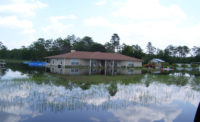Project 9: Large Loss Water Damage Restoration
Company: Cleantec
The job: A 26,000 square-foot commercial building situated next to a creek in a rural community suffered catastrophic flooding for 5 days.
The solution: Cleantec responded with a remediation plan that included a microbiologist, a tractor trailer that delivered dessicant dehumidifiers, an army of labor to empty the building and cut drywall, a cleanup team that worked tirelessly to sanitize the building and a team of managers to work through the financial impact on this small organization.
Challenges: The facility was a daytime center for individuals with disabilities, some with compromised immune systems. Facility contained 60+ offices, community rooms, printing shop, health clinic and other functions. The adjacent creek flooded twice in 72 hours, and 5 days passed before flood waters receded and remediation could begin, causing the building to absorb enormous amounts of moisture throughout. Water was contaminated with sewage and farmland runoff.
Project 10: Airport Air Traffic Control Tower Mold Remediation
Company: Wonder Makers Environmental (and others)
The job: In 2011, eight organizations joined forces and completed a two-year effort focused on the remediation of pervasive mold contamination throughout the air traffic control tower at the world's 25th busiest airport. This work included the removal and replacement of approximately 115,000 square feet of gypsum wallboard material, and nearly 20,000 square feet of 1" thick elevator shaft liner board—all while the critical use facility remained operational.
The solution: Implementation of a health survey to document baseline conditions and guide remediation actions.
- Integration of a safety/quality review for all work activities to ensure that there was no disruption to air traffic.
- Design of a system to put the elevator shaft under negative pressure while positively pressurizing the elevator car with filtered air.
- Research and selection of insulating materials for the poured concrete walls, which would prevent condensation and meet the fire code requirements for the building.
- Protection of the elevator shaft with cargo netting, allowing for the shaft walls to be dismantled and rebuilt while the elevator remained in operation.
- Utilization of a specially engineered scaffolding system for the stairwells, which provided access to the upper sections of the wall while maintaining the travel path underneath in case of emergency.
- Development of a secondary filtration system for the HEPA-filtered negative air machines to ensure that they could be safely exhausted back into the occupied areas of the building.
- Application of strict criteria for post-remediation air samples, requiring the remediation contractor to turn over work areas that were much cleaner than a normal fungal ecology.
- Use of on-site analysis for the evaluation of spore trap samples to provide real time information during critical remediation efforts.
Challenges: Four major challenges dominated the project.
- The airport traffic volume meant that work was being done in a critical use facility that operated 24/7/365.
- The building envelope was riddled with seven separate water intrusion sources and complex moisture migration patterns once water entered the structure.
- Investigation and remediation work needed to be conducted in a structure with sensitized individuals and extremely sensitive electronic equipment.
- Finally, the comprehensive nature of the inspection revealed a number of design and construction errors that were unrelated to the mold contamination but had to be addressed during the project in order for the building to meet health and safety codes.
Project 11: Asbestos Abatement on a WWII Destroyer
Company: Mill City Environmental Corporation
The job: MCE was contracted by National Park Service (NPS) to abate asbestos and clean 18 fuel tanks on the historic Naval Vessel the USS Cassin Young, a former World War II destroyer that now serves as a museum at the Charlestown Navy Yard. The ship needed hull repairs, so MCE prepared the areas for the Navy to perform maintenance.
The solution: Extra precautions were taken to ensure that MCE could properly re-assemble the parts once work was completed. Throughout the work onsite, extreme care was taken to avoid damage to the ship and to ensure that the USS Cassin Young would maintain its historical integrity once the work was completed.
Challenges: The ship’s tight quarters required creative engineering of containments and abatement plans to remove and repair the asbestos, while preserving and respecting the vessel’s rich history. Several areas could not be abated until MCE dismantled parts of the vessel to access the asbestos. Additionally, MCE had to remove removed fuel that had been sitting in the tanks since 1960.
Project 12: A Sewage Job for the Ages
Company: PuroClean of Delran
The job: An 8-inch soil line broke in the basement of a high-end condominium complex in downtown Philadelphia.
The solution: After pumping out the sewage and disposing of numerous dead rats that were also discovered in the area, plumbers were able to enter and clear the clog in the pipe. Plumbers had to rooter through 28 feet of pipe until the clog was cleared. Debris removal then commenced, then came sanitization. All of the affected areas were pressure-washed with a sanitizing solution, using cold water to avoid steaming up the sewage and making it go airborne. After the first round of sanitizing was complete, drying equipment was brought in to thoroughly dry the area. After this equipment was pulled, the walls and floor were hosed down with another sanitizer. In total, 3,000 gallons of raw sewage and 15 tons of contaminated debris was removed
Challenges: Debris removal was not easy. We formed three teams. Team one bagged the contaminated debris, team two moved the debris from the affected area about 100 yards to the stairs and team three hand-carried the debris up the stairs and out to the dumpster. We would change jobs periodically to give guys a break from the hard jobs.
(Editor’s Note: See this case study in the May 2015 issue of R&R)






Report Abusive Comment